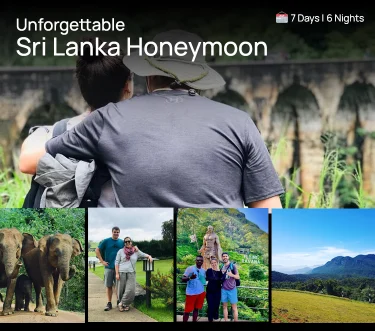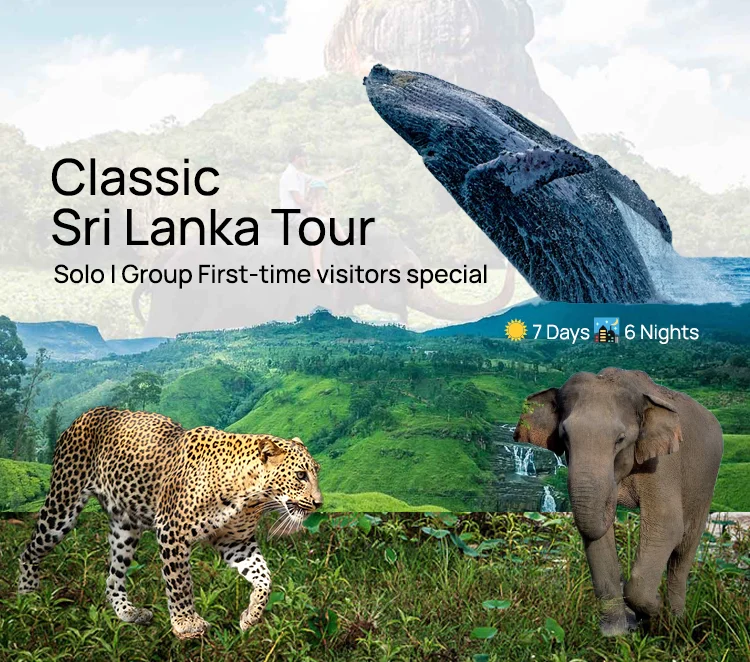Explore Ancient Buddhist Monastery Ruins Hidden in the Jungle of Sri Lanka
Sri Lanka is a treasure trove of ancient Buddhist sites tucked deep within lush jungles and remote forests. These sacred places, untouched by modern development, offer a glimpse into the country’s spiritual and architectural legacy. From monastic ruins overrun by vines to towering Buddha statues carved into rock faces, each site echoes with stories of devotion, healing, and history.
Here’s a curated list of some of the most awe-inspiring and jungle-hidden Buddhist heritage sites you can explore with Lanka Tour Driver.
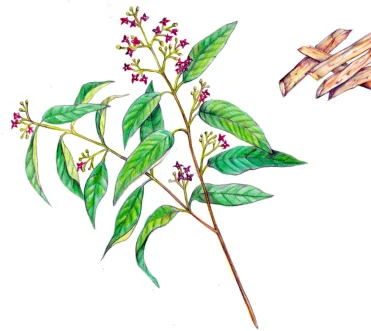
1. Ritigala – Medicinal Forest Monastery of the Ancient Sages
Hidden deep within the dense forest canopy of Sri Lanka’s North Central Province, Ritigala is an ancient Buddhist monastery complex that perfectly fuses spiritual heritage with ecological wonder. Rising to an elevation of 766 meters, Ritigala is the highest point in the region, creating a unique microclimate unlike the surrounding dry plains—cool, misty, and moist, even during hot seasons. This has allowed it to become a sanctuary for rare medicinal plants and herbs, many of which are endemic to the mountain and were traditionally used in Ayurvedic medicine..
A Retreat for Forest-Dwelling Monks (Pansakulika Monks)
Ritigala’s monastery dates back to at least the 1st century BCE, during the reign of King Sena I. It became home to Pansakulika monks, an ascetic sect of Buddhist clergy who lived with extreme simplicity and discipline. These monks avoided ornamental structures or statues and practiced meditation deep in nature, adhering strictly to Vinaya rules. The layout of the site—lacking stupas or image houses—reflects this minimalism and their focus on mindfulness.
Mysterious Ancient Architecture
The stone ruins at Ritigala are surprisingly advanced in design and construction. Visitors can walk through:
- Stone-paved walkways
- Bathing ponds and reservoirs (such as Banda Pokuna)
- Meditation platforms
- Raised stone bridges and balustrades
Each structure is placed with precision, often aligned to natural water flows and shaded areas—an architectural approach rooted in harmony with the environment.
Unique Medicinal Plants and Herbs
Ritigala is designated as a Strict Nature Reserve by the Department of Wildlife Conservation, meaning human activity is tightly regulated to protect its sensitive ecosystems. The mountain hosts a range of herbal plants still used in traditional Sri Lankan medicine, including:
- Aegle marmelos (Beli)
- Terminalia chebula (Aralu)
- Phyllanthus emblica (Nelli)
- Piper species (Wild pepper)
- Santalum album (Sandalwood)
Some legends even claim that Ritigala was part of the Himalayan chunk dropped by Hanuman, as mentioned in the Ramayana—explaining the presence of Himalayan flora.
A Living Legend and Conservation Symbol
The atmosphere at Ritigala is one of tranquility, mystery, and spiritual depth. The site has no modern infrastructure, which preserves its authenticity and untouched charm. You’re more likely to encounter monkeys, lizards, and rare birds than other tourists. This natural silence is what once drew monks here, and today, it draws mindful travelers and heritage lovers alike.
2, Nalanda Gedige – A Temple of Cultural Fusion Hidden in the Heart of Sri Lanka
In the quiet countryside near Matale lies Nalanda Gedige, one of Sri Lanka’s most intriguing and symbolically rich archaeological sites. What makes this temple so special is not just its antiquity but its unique architectural blend of Hindu and Buddhist elements—making it a rare representation of multi-religious harmony during a time when Sri Lanka was a crossroads of cultures, trade, and spiritual thought.
Location and Setting
Nalanda Gedige is located approximately 20 km north of Matale in Sri Lanka’s Central Province. Surrounded by lush greenery and quiet villages, the site was originally discovered partly buried underground. Due to the construction of the Bowatenna Reservoir in the 1970s, it was carefully dismantled and relocated to its current location—on an artificial island created within the reservoir itself. This tranquil setting enhances the temple’s mystique and makes it a peaceful place to explore.
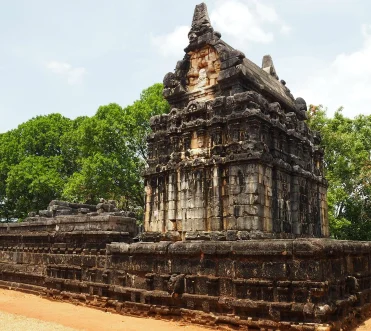
Architectural Significance – A Dravidian-Buddhist Fusion
What makes Nalanda Gedige stand out is its striking resemblance to South Indian Hindu shrines, particularly those built in the Pallava or Chola architectural style (Dravidian). Features like the gopuram-like entrance, ornate stone carvings, and domed roof are all traditionally associated with Hindu temples.
However, once inside, the layout and iconography become uniquely Buddhist:
- There is no central deity statue, as you’d find in a typical Hindu shrine.
- The sanctum (garbhagriha) layout follows early Mahayana Buddhist traditions, hinting at a period when Buddhist and Hindu philosophies intertwined.
- Some scholars believe the temple was associated with Tantric Buddhism, which had flourished in South Asia during the 8th–10th centuries.
This dual religious identity is why Nalanda Gedige is often referred to as a “fusion temple”—a symbol of religious tolerance and cultural synthesis in ancient Sri Lanka.
Historical Background
The temple is believed to have been constructed between the 8th and 10th centuries AD, a time when both Mahayana Buddhism and Hindu Shaivism had influential followings in Sri Lanka. While Buddhism was predominant, influences from South India (especially the Cholas and Pandyas) had made their mark culturally and architecturally.
Its precise religious use remains debated—some claim it was a Tantric Buddhist shrine, while others argue it had dual use, adapting to the prevailing socio-political climate.
What You’ll See Today
Today, Nalanda Gedige stands fully reconstructed on a manicured garden island. Though small in size, it captivates visitors with:
- Intricately carved floral, animal, and geometric stone motifs
- A serene panoramic view of the surrounding reservoir and hills
- Unusual stone alignments and perfect symmetry
- A spiritual atmosphere perfect for quiet reflection or photography
Travel Tips
- 📅 Best Time to Visit: Morning or late afternoon for soft lighting and fewer crowds.
- 📍 Nearest Town: Matale, easily accessible via Kandy or Dambulla.
- 🚗 Ideal Travel Option: A private car tour with a knowledgeable local guide—such as through Lanka Tour Driver—ensures a seamless journey and deeper insights into the site’s significance.
3. Reswehera Rajamaha Viharaya – Forest Shrine of Dual Buddhas
Nestled within the tranquil green cover of Sri Lanka’s North Central Province, Reswehera Rajamaha Viharaya is a lesser-known yet spiritually significant temple with a history that spans over 2,300 years. It is revered for housing two iconic Buddha images—one carved into a rock face and the other enshrined inside a cave temple—both radiating timeless serenity in the heart of the jungle.
A Sacred Site Wrapped in Seclusion
Located near Galgamuwa, about 20 km from the Dambulla-Kurunegala main road, Reswehera Viharaya is not on the average tourist trail, making it a perfect stop for those who wish to experience authentic Sri Lankan Buddhist heritage without the crowds. Surrounded by paddy fields, forest patches, and a peaceful rural landscape, the site retains a meditative calm that mirrors the very principles of Buddhism.
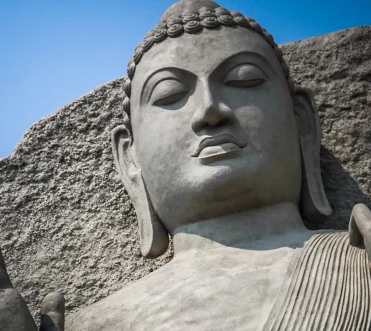
Historical and Religious Background
The temple is believed to have been established during the reign of King Devanampiyatissa in the 3rd century BCE, shortly after the introduction of Buddhism to Sri Lanka by Arahat Mahinda Thero. The site later flourished during the Anuradhapura and Polonnaruwa periods as a regional spiritual hub.
According to local chronicles and inscriptions, Reswehera was a place where monks practiced Vipassana meditation in forest caves, following the traditional Aranya (forest monk) tradition. This lends the site a deep connection to early Theravāda Buddhism and the monastic lifestyle.
The Dual Buddha Statues
What makes Reswehera Rajamaha Viharaya especially intriguing is the presence of two Buddha statues, both believed to be over 1,000 years old:
- Rock-Cut Buddha Statue
Carved directly into the vertical rock surface, this imposing 39-foot-high statue is a breathtaking sight. The statue is depicted in the Abhaya Mudra (gesture of fearlessness), symbolizing protection and reassurance. Its artistic style resembles that of late Anuradhapura or early Polonnaruwa craftsmanship, and though weathered, the features remain graceful and powerful. - Cave-Enshrined Seated Buddha
Just a few steps away, within a natural cave, rests a seated Buddha statue adorned with serene expression and symbolic mudras. It is accompanied by ancient murals, inscriptions, and a sacred bo tree (Bodhi) believed to be a sapling of the original Jaya Sri Maha Bodhi.
Together, these statues signify the inner and outer manifestations of enlightenment—a symbolic reminder of the balance between meditative stillness and compassionate action.Inscriptions and Archaeological Significance
Scattered around the temple are stone inscriptions (some in Brahmi script), cave dwellings with meditation platforms, and ruins of ancient structures. These reveal Reswehera’s historical role as an active monastery, potentially serving as a hermitage or forest retreat for monks.
Several prehistoric artifacts and pottery fragments have also been unearthed nearby, suggesting that the site may have had spiritual importance even before the advent of Buddhism.
A Living Spiritual Heritage
Unlike many heritage sites that exist only as ruins, Reswehera remains an active place of worship, with resident monks and regular rituals. Pilgrims visit to pay homage, meditate beneath the Bodhi tree, or participate in poya (full moon) observances. The temple also attracts those seeking blessings for peace, healing, and guidance.
How to Visit Reswehera with Ease
- 🗓 Best Time to Visit: Early morning or late afternoon (for soft light and cooler weather)
- 📍 How to Reach: Easily accessible from Dambulla or Kurunegala; ideal as a cultural detour with a private driver
- 🚗 With Lanka Tour Driver: Customize your day trip to include Reswehera, Avukana Buddha, and Ritigala—all within close proximity
You can book your tour with Lanka Tour Driver to enjoy the venu, Check our Packages
4. Avukana Buddha Statue – Towering Icon of Serenity in Sri Lanka
Rising majestically from a rocky hillside near the Kala Wewa reservoir, the Avukana Buddha Statue is one of the most iconic and well-preserved ancient Buddha sculptures in Sri Lanka. Carved out of a single granite cliff face, this towering image—standing over 12 meters (40 feet) tall—is a timeless expression of spiritual calm and artistic genius from Sri Lanka’s ancient Anuradhapura period.

Location and Setting
Located near Kekirawa, just 30 km north of Dambulla and close to Kala Wewa, the statue is easily accessible on a day trip through Sri Lanka’s Cultural Triangle. The setting is peaceful, with the statue framed by forested hills and the waters of the ancient reservoir, adding a natural aura to its meditative presence.
Historical Background – The Masterpiece of King Dhatusena
The Avukana Buddha Statue is believed to have been built in the 5th century CE during the reign of King Dhatusena, a ruler famous for major irrigation works like the Kala Wewa tank. According to local legend, the statue was part of a friendly competition between master and apprentice sculptors, with Avukana’s figure emerging as the more refined and graceful.
Its historical significance lies in:
- Its representation of Mahayana influence in Sri Lankan Theravāda art
- Advanced stone-carving techniques used over 1,500 years ago
- The combination of religious devotion and engineering mastery under King Dhatusena’s patronage
Artistic and Symbolic Features
The statue portrays the Buddha standing in the Asisa Mudra (gesture of blessing or reassurance), with his right hand raised near the shoulder. Carved from solid rock, the figure:
- Stands 12 meters tall, with a beautiful vertical proportion
- Features intricately carved robes that cling to the body, revealing the contours of the torso—a testament to stone-carving brilliance
- Has a separate carved pedestal shaped like a lotus flower, which may have been added later
Unlike other freestanding Buddha statues, the Avukana statue is still connected to the original rock, giving it stability while preserving its authenticity.
Spiritual Significance
The Avukana Buddha represents not just artistic excellence, but also the spiritual ideals of calmness, clarity, and compassion central to Buddhist philosophy. The statue faces east, toward the Kala Wewa, possibly symbolizing the Buddha offering blessings to the life-giving water reservoir.
Devotees and pilgrims visit the site to offer flowers, light oil lamps, and meditate in the presence of this towering embodiment of serenity.
Architectural Context
The statue once belonged to a larger vihara (temple complex), traces of which remain in nearby foundations, ruined buildings, and a cave shrine. These suggest it was an important monastic center that attracted both monks and laypeople during its peak.
Inscriptions and archaeological studies indicate this region flourished under Anuradhapura and early Polonnaruwa periods, forming part of a vibrant cultural and spiritual network.
Travel Experience
For modern travelers, standing at the foot of the Avukana Buddha is a humbling experience. The sheer scale and serene expression of the statue create a silent dialogue between the ancient world and the present moment.
- 📷 Photography Tip: Visit during early morning or golden hour for the best lighting on the stone surface.
- 💬 Cultural Etiquette: Wear modest clothing and remove shoes when approaching the altar.
5. Buduruwagala – Mystical Rock-Cut Mahayana Statues of Wellawaya
Hidden deep in the dry zone forest near Wellawaya in Sri Lanka’s Uva Province, Buduruwagala is one of the country’s most enigmatic and awe-inspiring ancient Buddhist sites. Translating to “the rock with the Buddha image” (in Sinhala: Budu-Ruwa-Gala), this sacred site features seven towering rock-cut figures, including the tallest ancient Buddha statue in Sri Lanka, believed to date back to the 9th or 10th century CE.
Location and Accessibility
Buduruwagala is situated about 5 km southeast of Wellawaya town. Surrounded by dense forest and quiet marshland, it offers a peaceful and meditative atmosphere far removed from the commercial tourist trail. The journey to the site—past village roads and lotus ponds—adds to its mystical charm.
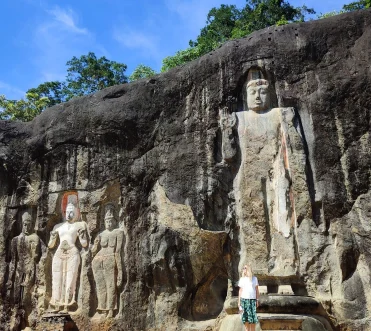
Historical and Religious Significance
Unlike the Anuradhapura or Polonnaruwa monuments rooted in Theravāda Buddhism, Buduruwagala reflects Mahayana Buddhist influence, which became prominent in Sri Lanka during the later Anuradhapura period.
- The central standing Buddha figure, measuring 15.5 meters (51 feet) in height, is believed to represent Dipankara Buddha, one of the Buddhas of the past.
- Flanking him are six other figures—three on each side—believed to be Mahayana Bodhisattvas, including Avalokiteshvara (the Bodhisattva of Compassion) and possibly Tara, a rare female deity figure in Sri Lankan Buddhist iconography.
These figures are carved into a single vertical rock face with remarkable precision and spiritual grace, giving Buduruwagala its status as one of Sri Lanka’s most unique Buddhist relics.
Artistic Features and Mystical Details
What sets Buduruwagala apart is not just the scale of the carvings but the fine artistic detail:
- The central Buddha stands in a samabhanga posture (upright and symmetrical) with elongated earlobes and a faint smile that radiates serenity.
- The Avalokiteshvara figure is adorned with a headdress, while another figure is believed to depict Prince Sudhana from Mahayana lore.
- Some of the carvings still retain traces of ancient stucco and color pigment, especially around the torso—an extremely rare survival in rock art.
- A small, mysterious flame-shaped oil stain appears near the right arm of the central Buddha. This has led to local legends claiming it is a miraculously burning flame, even though there is no known fuel source—adding a mystical aura to the site.
Spiritual and Meditative Ambience
Buduruwagala is less of a temple and more of a meditative sanctuary carved into nature itself. The surrounding stillness of the forest, the chirping of birds, and the gentle breeze from the wetlands create a contemplative atmosphere. Monks and pilgrims often come here to meditate or conduct simple offerings at the foot of the statues.
How to Visit Buduruwagala with Lanka Tour Driver
- 📍 From Ella or Wellawaya: Ideal for a half-day or full-day trip when traveling between Ella, Kataragama, or Yala National Park.
- 🚗 With Lanka Tour Driver: Travel comfortably through rural routes with insight from a knowledgeable local driver who can explain the legends and iconography.
- 📷 Best Time to Visit: Early morning or late afternoon—when the carvings are bathed in golden light and fewer visitors are around.
Frequently Asked Questions
What are the best hidden ancient Buddhist monastery ruins to visit in Sri Lanka?
The best hidden Buddhist monastery ruins include Ritigala Monastery, Arankele Forest Hermitage, and the ancient caves of Dimbulagala—all nestled deep within Sri Lankan jungles.
Is Ritigala an ancient Buddhist site worth visiting for spiritual travelers?
Yes, Ritigala is a sacred and ancient Buddhist site in Sri Lanka ideal for spiritual travelers seeking tranquility and historical depth away from tourist crowds.
Are there Buddhist forest monasteries in the Knuckles Mountain Range in Sri Lanka?
Yes, the Knuckles Range in Sri Lanka shelters ancient Buddhist forest monasteries perfect for trekking travelers interested in history and meditation.
Are Sri Lanka’s jungle monasteries suitable for meditation and mindfulness travel?
Absolutely. These remote monastery ruins in Sri Lanka’s jungles are ideal for mindfulness travel, offering peace, seclusion, and a spiritual ambiance.
How do I visit ancient jungle monasteries in Sri Lanka on a guided tour?
You can book a private cultural heritage tour through trusted travel providers like Lanka Tour Driver to explore hidden jungle monasteries with expert guides.
By following these guidelines, you’ll not only show respect for Sri Lanka’s sacred places but also enrich your own experience of these timeless spiritual treasures. Enjoy your journey through Sri Lanka’s hallowed halls of worship – it’s sure to be as enlightening as it is unforgettable!
